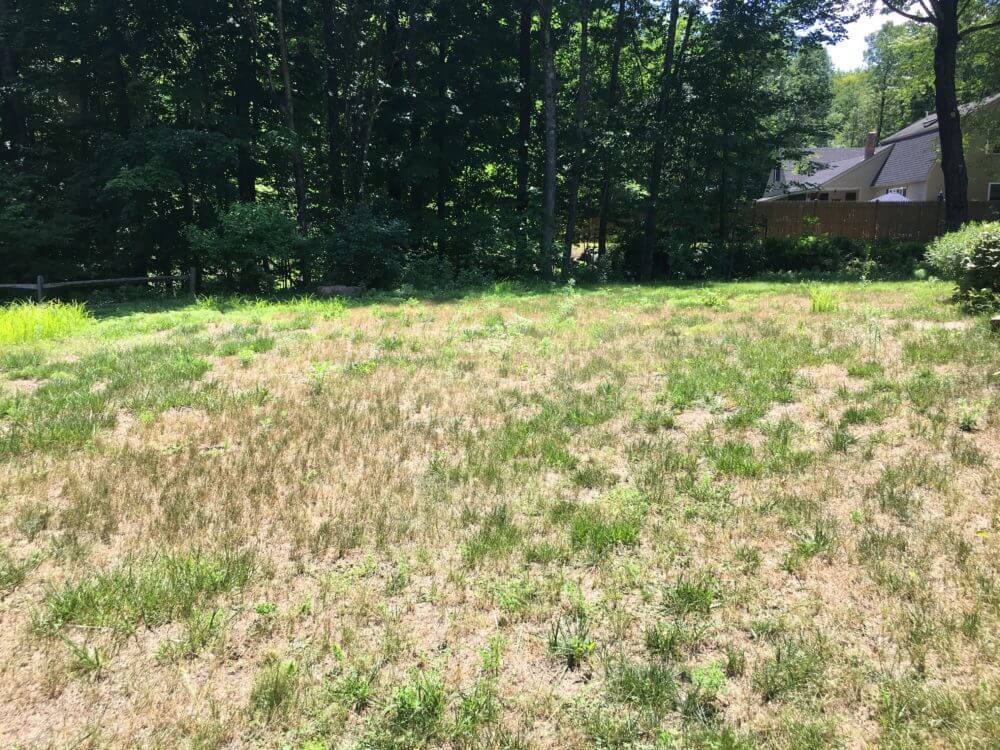While there are a wide variety of reasons why your lawn’s appearance is less than spectacular, there are some basic underlying issues that are a common thread, whether it be a quick or slow demise of the home lawn. Regardless of how the damage occurred, the result will be the same – lost turf will be replaced by weeds and crabgrass.
Insects
The top 10 damaging Insects in New England are seven white grub varieties, chinch bugs, webworms and billbugs. While grubs do their damage below ground, they often attract crows and skunks that can cause significant surface damage as they dig for food. The direct damage from grubs and the related foraging damage can range from small patches to an entire lawn. The above-ground damage from chinch bugs can range from small patches in the sun to an entire lawn being destroyed. The above-ground damage caused by sod webworm and billbugs thankfully have a smaller impact.
Sunny lawns are at highest risk for both grub and chinch bug damage because these pests prefer hot, sunny locations versus shade. Grub damage is most visible in the spring and fall, when the grubs are actively feeding. Chinch bug damage can manifest in the late spring to late summer as small patches, growing outward as the insects move into fresh lawn area. This damage has the appearance of drought, making diagnosing this pest all the more important. Since chinch bug populations escalate over time and from year-to-year, a lawn can be lost in a season or two if counter measures are not employed.
Diseases
Lawns can also be quickly damaged by diseases, often thinning out a lawn in patches, depending upon the time of year. Leaf spot is more common in the spring, while summer patch disease can cause permanent scars and pits – especially in sod lawns under drought/heat stress. Brown patch appears in the summer and can thin a lawn out literally overnight with the right combination of high temperatures and humidity. Prevention is the best medicine when it comes to diseases including proper mowing height, sufficient soil moisture, compost tea or seaweed sprays, and fungicides as needed.
Poor Lawn Care Practices
More insidious means of a lawn thinning out and declining over time are poor lawn care practices, or what we call in the business, the lack of proper cultural care practices. These include mowing too short or even scalping a lawn, lack of debris cleanup (leaf removal), not allowing clippings to naturally enrich the soil, mowing during the heat of the day, improper watering or the inability to irrigate under critical weather conditions such as extended heat/drought conditions.
Mowing
Nothing will thin out a lawn quicker and open the castle gate to weeds and crabgrass than mowing short or worse yet, scalping the lawn to the point where the blade makes contact with the soil. Short mowing allows the soil to super heat during the summer and promotes all kinds of dormant weed seeds to germinate and grow. The weed population then becomes a competitor for light, space, water, and nutrients – easily outgrowing any surrounding weak or dormant grass. The cascading affect only worsens as surrounding grass continues to die allowing more weeds to germinate and grow. Under extended drought conditions, no mowing should occur. Over a few years, a good lawn can be lost due to improper mowing. For more mowing tips visit www.mrgrassblog.net
Debris Cleanup
A poor fall or spring cleanup of debris such as leaves, sticks, sand used in plowing, and gravel all become mulching agents on the surface of the lawn. Left in place, sections of grass can die off in mere weeks under piles of leaves, sand, or gravel. For more information on fall cleanup visit www.mrgrassblog.net
Watering
When grass has no access to rainfall for more than a month, the growing part of the plant (the crown) is more likely to die from a lack of water. Some irrigation – as little as 20 minutes once or twice a week, in the early or late morning, is the minimum just to keep the grass crowns alive. For more watering tips visit www.mrgrassblog.net
Combine insect and or disease activity with poor cultural practices and chances are your lawn has a lot of moss, crabgrass, and or open dusty dirt areas – not really a lawn at all. Once it’s lost, you will need to start again to replace lawn and then care for it to mitigate the forces waiting to cause harm.


